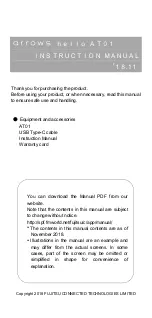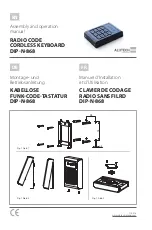
Global mode
642
Key Transpose
can be controlled by the MIDI
universal system exclusive message Master Coarse
Tuning (F0, 7F, nn, 04, 04, vv, mm, F7: nn=MIDI
channel, vv/mm=value).
These messages are received on the global MIDI
channel specified by
MIDI Channel
(1–1a).
In Program, Combination, and Sequencer modes,
MIDI RPN messages can be received to control the
tuning and transposition of the program or timbre
(Combination mode) or track (Sequencer mode).
Incoming MIDI RPN Fine Tune messages will make
relative adjustments to the tuning specified by the
Master Tune
setting.
MIDI RPN Coarse Tune messages will make relative
adjustments to the pitch specified by the
Key
Transpose
setting. In Program mode these messages
will be received on the global MIDI channel
specified by
MIDI Channel
(1–1a), and in other
modes they will be received on the MIDI channel
specified for each timbre or track. (
Detune
,
Transpose
Combination 2–3a, Sequencer 2–3a)
Velocity Curve
[1…8]
This specifies the way in which the volume and/or
tone will change in response to variations in keyboard
playing dynamics (velocity).
When
Convert Position
(1–1a) is PreMIDI, variations
in keyboard playing dynamics will affect the velocity
effect and the transmitted velocity data as shown in the
left-hand diagram below.
Incoming data will automatically use the velocity
curve number 4 shown in the right-hand diagram.
With a setting of PostMIDI, variations in keyboard
playing dynamics (and in the velocity of incoming
data) will respond as shown in the right-hand diagram
below. If you are playing OASYS’s tone generator from
an external keyboard or sequencer, and the overall
sound is too bright or too dark, you can set the
Convert Position
parameter to PostMIDI and select
the appropriate velocity curve here.
For the transmitted data, the velocity curve number 4
shown in the left-hand diagram will automatically be
selected.
1, 2, 3:
An effect will be obtained for strongly-played
notes
4 (Normal):
The normal curve
5, 6:
An effect will be obtained even if you do not play
very strongly
7:
A certain amount of effect will be obtained even for
softly-played notes
8:
This curve produces the most regular effect. This
setting is suitable when you do not need velocity
sensitivity, or when you wish to make the notes more
consistent. However with this curve, control of softly-
played notes will be more difficult, so use the curve
that is most appropriate for your playing strength and
style, and the effect that you wish to produce.
After Touch Curve
[1…8]
This specifies the way in which the volume and/or
tone will change in response to variations in pressure
(after touch) applied to the keyboard while playing a
note.
When
Convert Position
(1–1a) is
PreMIDI
, variations
in after touch pressure will affect the after touch effect
and the transmitted after touch data as shown in the
left-hand diagram below.
Incoming data will automatically use the after touch
curve number
3
shown in the right-hand diagram.
With a setting of
PostMIDI
, variations in after touch
pressure (and in the value of incoming after touch
data) will create change as shown in the right-hand
diagram.
For the transmitted data, the after touch curve number
3
shown in the left-hand diagram will automatically be
selected.
1, 2:
This curve produces change when strong after
touch pressure is applied
3 (Normal):
The normal curve
4, 5:
This curve produces change even when light
pressure is applied
6, 7:
These curves produce change in 24 or 12 steps
respectively, and are appropriate for when you are
recording after touch data on the sequencer and wish
to conserve memory. (Set the
Convert Position
to
PreMIDI.) Curve number 7 allows change over twelve
steps, so when using after touch to modify the pitch,
you can set the range of modification to one octave,
and use after touch to vary the pitch in semitone steps.
8:
This is a random curve. Use this when you wish to
create special effects, or to use after touch to apply
unpredictable modulation.
When
Convert Position
(1–1a) is PreMIDI, the
setting you make here will be applied immediately
after the keyboard, meaning that it will affect the
data transmitted via MIDI, but will not affect the
received data.
With a setting of PostMIDI, the setting you make
here will be applied immediately before the
OASYS’s internal tone generator, meaning that it
will affect the data received via MIDI, but will not
affect the transmitted data.
1
MAX
127
1
8
6
5
4
3
2
7
Soft
127
Strong
1
1
2
3
8
6
5
4
7
For a setting of
PostMIDI
Velocity
effect
Velocity (MIDI In
→
TG)
For a setting of
PreMIDI
Velocity (KBD
→
MIDI Out)
3
4
5
7
2
1
6
Soft
127
Strong
0
8:RANDOM
1
0
MAX
127
3
4
5
7
2
6
8:RANDOM
For a setting of
PreMIDI
After Touch (KBD
→
MIDI Out)
For a setting of
PostMIDI
Aftertouch
effect
After Touch (MIDI In
→
TG)
Содержание Electronic Keyboard
Страница 1: ...Parameter Guide Parameter Guide ...
Страница 2: ......
Страница 180: ...Program mode EXi 170 ...
Страница 290: ...EXi STR 1 Plucked String 280 ...
Страница 572: ...Sequencer mode 562 ...
Страница 700: ...Global mode 690 ...
Страница 751: ...Insert Effects IFX1 IFX12 Routing 741 Fig 2 3a Fig 2 3b ...
Страница 902: ...Effect Guide 892 ...
















































